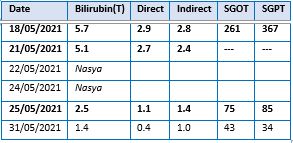A case report on effect of Dronapushpi Swarasa Nasya in Kamala induced Hyperbilirubinemia
Keywords:
Kamala, Virechana, Dronapushpi Swarasa, Shodhana Nasya, Hyper-BilirubinaemiaAbstract
Human body eliminates metabolic wastes either through sweat, urine, or through faeces. Any derangement in the normalcy leads to building up of metabolic wastes within the body. One such condition where in there is accumulation of bilirubin in the blood is hyperbilirubinemia. Viral infection is the cause and presenting with yellowish discoloration of sclera, dark urine, pale stool, fatigue, flu like symptoms, loss of appetite etc. In Ayurveda, such symptoms are mentioned under the broad name Kamala. The line of management mainly highlights the advice of Shodhana in the form of Virechana and different Shamana Aushadhis based on the stages of the disease. In traditional folklore practice, the patients of these symptoms are treated with Tikshna, Shodhana Nasya Karma. With that practice in backdrop, a 17 years female patient presented with hyper-bilirubinaemia, was treated with Dronapushpi Swarasa Nasya ten drops to each nostrils, in a gap of 2 days. When the bilirubin level was raising gradually even after usual internal medication, this treatment was planned and administered. The bilirubin level from 5.7 was reduced to 1.4 after the treatment gradually over a period of 12 days. The patient showed gradual recovery from almost all the symptoms clinically and in haematological parameters. During the procedure nasya did not show any complications in the patients. Dronapushpi Swarasa can be effectively used to manage hyper-bilirubinaemia.
Downloads
References
Davidson, Edited by brain R. Walker, Davidsons Principles and practice of medicine, 22nd edition, Daibetic neuropathy, page 831, syear-2006
Green JB, Bethel AN, Armstrong PW, Duse JB, Engel SS, Garg J, et al. Effect of Sitagliptin on cardiovascular outcomes in type II Diabetes. New England Journal of Medicine, 2015; 232 -242
Sushruta, Sushruta Samhita, Chakrapanidatta, 14th edition. 2017, Chaukamba Sanskrit Samsthan, Varanasi, Pg- 310
Vaidya Bapalal G, Adharsha Nighantu, Vol-II, II edition, Varanasi, Chowkambha Bharti Academy. 1999, p-279-280.
Rohkamm, Reinhard. Color atlas of neurology. III. by Manfred Guther.Transl.rev.by Ethan Taub.2004;p.90
W. Chien, K.S.E.Su, S.-F. Chang. Nasal systemic drug delivery, Marcel Dekker, Inc., New York,1989.















